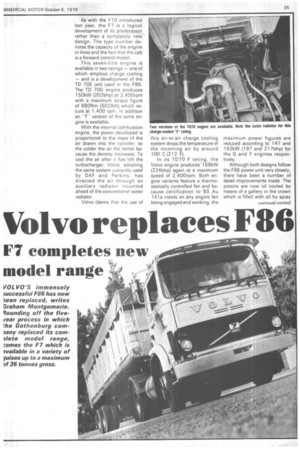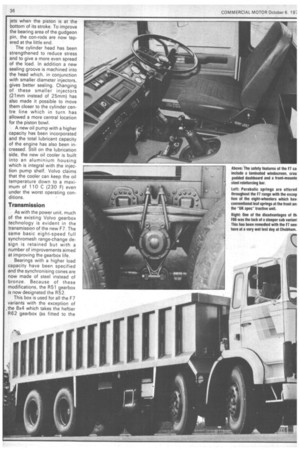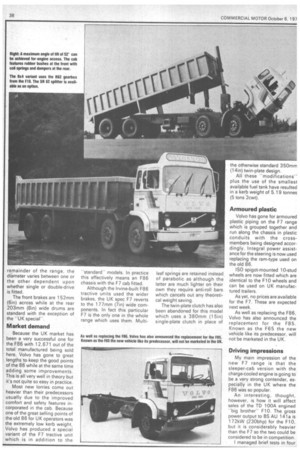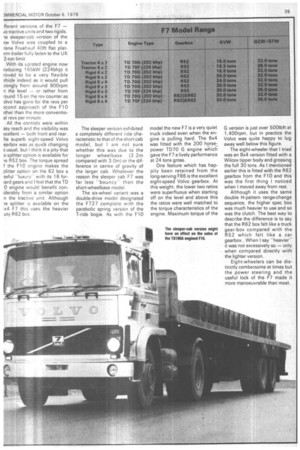As with the F10 introduced last year, the F7 is
Page 39

Page 40

Page 41

Page 42

Page 43

If you've noticed an error in this article please click here to report it so we can fix it.
a logical development of its predecessor rather than a completely new design. The type number denotes the capacity of the engine in litres and the fact that the cab is a forward control model.
This seven-litre engine is available in two ratings — one of which employs charge cooling — and is a development of the TD 70E unit used in the F86. The TD 700 engine produces 150kW (202bhp) at 2,400rprn with a maximum torque figure of 680Nm (502Ibft) which occurs at 1,400 rpm. In addition an "F" version of the same engine is available.
With the internal combustion engine, the power developed is proportional to the mass of the air drawn into the cylinder, so the colder the air the better because the density increases. To cool the air after it has left the turbocharger, Volvo, adopting the same system currently used by DAF and Perkins, has directed the air through an auxiliary radiator mounted ahead of the conventional water radiator.
Volvo claims that the use of this air-to-air charge cooling system drops the temperature of the incoming air by around 100 C(212 F).
In its TD70 F rating, the Volvo engine produces' 168kW (224bhp) again at a maximum speed of 2,400rpm. Both engine variants feature a thermostatically controlled fan and because certification to BS Au 141a insists on any engine fan being engaged and working, the
maximum power figures are reduced according to 147 and 162kW (197 and 21713hp) for the G and F engines respectively.
Although both designs follow the F86 power unit very closely, there have been a number of detail improvements made. The pistons are now oil cooled by means of a gallery in the crown which is filled with oil by spray jets when the piston is at the bottom of its stroke. To improve the bearing area of the gudgeon pin, the con-rods are now tapered at the little end.
The cylinder head has been strengthened to reduce stress and to give a more even spread of the load. In addition a new sealing groove is machined into the head which, in conjunction with smaller diameter injectors, gives better sealing. Changing of these smaller injectors (21rnm instead of 25mm) has also made it possible to move them closer to the cylinder centre line which in turn has allowed a more central location for the piston bowl.
A new oil pump with a higher capacity has been incorporated and the total lubricant capacity of the engine has also been increased. Still On the lubrication side, the new oil cooler is built into an aluminium housing which is integral with the injection pump shelf. Volvo claims that the cooler can keep the oil temperature down to a maximum of 110 C (230 F) even under the worst operating conditions.
Transmission
As with the power unit, much of the existing Volvo gearbox technology is evident in the transmission of the new F7. The same basic eight-speed full synchromesh range-change design is retained but with a number of improvements aimed at improving the gearbox life.
Bearings with a higher load capacity have been specified and the synchronising cones are now made of steel instead of bronze. Because of these modifications, the R51 gearbox is now designated the R52.
This box is used for all the F7 variants with the exception of ,the 8x4 which takes the heftier R62 gearbox (as fitted to the
F10) with the SR62 splitter being available on option to give the 16 forward speeds. Whereas the F88 was available with the splitter, the option was never extended to the 86. The single-drive eight-wheeler stays with the R52 gearbox.
For operators who want a fully automatic transmission, the five-speed Allison MT 650 can be specified.
The rear axle used on the F10 is now used for the F7. It is a single-reduction hypoid-bevel design with a choice of ratios, 4.86 and 5.43 to 1. On double-drive chassis, the well known Volvo —T-ride" non-. reactive bogie is fitted. Ratios of 5.43 to 6.41 to 1 are available on the 8x4. These two ratios are also included in the 6x4 specification along with a third choice of 4.87 to 1. The bogie design capacity stays at 20 tons.
At the front, the axles are drop forged in I-beam section while the capacity has been increased to 6.5 tons.
New cab
The most obvious new feature is the cab which is a development of the original Club of Four design. Most of the members of the Club (DAF, Saviem, Magirus Deutz and Volvo) now seem anxious to deny the origins of 'any Club inspired vehicle and Volvo is no exception, but the fact remains that Volvo has used the Club cab as the basis for the F7 as did Saviem with the H-series• launched last year.
The F7 cab is an all-steel design which tilts to a maximum angle of 52 for component access. One of the drawbacks of the 86 was the fact that it was available in short cab form only and, because of the doubleskinned curved profile, it was difficult to produce a sleeper conversion. This has been remedied with the F7 which is available on the 3.2m (1 Oft 6in) wheelbase chassis while the 3.0m (9ft 10in) model retains the short cab.
Parabolic leaf springs are offered as standard throughout the range with the exception of the eight-wheelers (and a UK spec tractive unit which I will come to later). The eight-wheelers, both single and double-drive use parabolic springs at the rear and conventional multi-leaf springs at the front.
With weight saving in mind, an aluminium fuel tank of,circular section is standard equipment on the tractive unit while a rectangular pressed steel type is used on the remainder of the range. The aluminium tank is of 345-litre (76ga1) capacity while the standard tank on the rigids is of 300 litres (66gal) capacity with options of 200 and 400 litres (44 and 88gal).
The braking system is full air with spring brakes for parking while load-sensing valves are fitted on all single-drive units. The drum diameter is 413mm (161/4in) at the front and 394mm (151/2in) at the rear for the tractive unit. For the
remainder of the range, the diameter varies between one or the other dependent upon whether single or double-drive is fitted.
The front brakes are 152mm (6in) across while at the rear 203mm (81n) wide drums are standard with the exception of the "UK special".
Market demand
Because the UK market has been a very successful one for the F86 with 12,671 out of the total manufactured being sold here, Volvo has gone to great lengths to keep the good points of the 86 while at the same time adding some improvements. This is all very well in theory but it's not quite so easy in practice.
Most new lorries come out heavier than their predecessors usually due to the improved comfort and safety features incorporated in the cab. Because one of the great selling points of the old 86 for UK operators was the extremely low kerb weight, Volvo has produced a special variant of the F7 tractive unit which is in addition to the "standard" models. In practice this effectively means an F86 chassis with the F7 cab fitted.
Although the Irvine-built F86 tractive units used the wider brakes, the UK spec F7 reverts to the 177mm (7in) wide components. In fact this particular F7 is the only one in the whole range which uses them. Multi leaf springs are retained instead of parabolic as although the latter are much lighter on their own they require anti-roll bars which cancels out any theoretical weight saving.
The twin-plate clutch has also been abandoned for this model which uses a 380mm (15in) single-plate clutch in place of the otherwise standard 350mm (14in) twin-plate design.
All these "modifications" plus the use of the smallest available fuel tank have resulted in a kerb weight of 5.19 tonnes (5 tons 2cwt).
Armoured plastic
Volvo has gone for armoured plastic piping on the F7 range which is grouped together and run along the chassis in plastic conduits with the crossmembers being designed accordingly. Integral power assistance for the steering is now used replacing the ram-type used on the old 86.
ISO spigot-mounted 10-stud wheels are now fitted which are identical to the F10 wheels and can be used on UK manufactured trailers.
As yet, no prices are available for the FT These are expected next week.
As well as replacing the F86, Volvo has also announced the replacement for the F85. Known as the F65 the new vehicle like its predecessor, will not be marketed in the UK.
Driving impressions
My main impression of the new F7 range is that the sleeper-cab version with the charge-cooled engine is going to be a very strong contender, especially in the UK where the F86 was so popular.
An interesting, thought, however, is how it will affect sales of the TO 100A engined "big brother" F10. The gross power output to BS AU 141a is 172kW (230bhp) for the Fl 0, but it is considerably heavier than the F7 so the two could be considered to be in competition.
I managed brief tests in four fferent versions of the F7 — vo tractive units and two rigids. le sleeper-cab version of the aw Volvo was coupled to a rane Fruehauf 40ft flat plat)rm trailer fully laden to the UK 2-ton limit.
With its uprated engine now roducing 165kW (224bhp) it roved to be a very flexible ahicle indeed as it would pull trongly from around 900rpm n the level — or rather from round 15 on the rev counter as olvo has gone for the revs per Licond approach of the F10 ither than the more conventioal revs per minute.
All the controls were within asy reach and the visibility was xcellent — both front and rear. he superb eight-speed Volvo earbox was as quick changing s usual, but I think it a pity that o splitter option is available for le R52 box. The torque spread f the F10 engine makes the plitter option on the 62 box a seful "luxury" with its 16 forrard gears and I feel that the TD 0 engine would benefit coniderably from a similar option n the tractive unit. Although le splitter is available on the :x4 F7 this uses the heavier uty R62 box.
The sleeper version exhibited a completely different ride characteristic to that of the short cab model, but I am not sure whether this was due to the longer wheelbase (3.2m compared with 3.0m) or the difference in centre of gravity of the larger cab. Whatever the reason the sleeper cab F7 was far less "bouncy.' than the short-wheelbase model.
The six-wheel variant was a double-drive model designated the F727 complete with the parabolic spring version of the T-ride bogie. As with the F10
model the new F7 is a very quiet truck indeed even when the engine is pulling hard. The 6x4 was fitted with the 200 horsepower TD70 G engine which gave the F7 a lively performance at 24 tons gross.
One feature which has happily been retained from the long-serving F86 is the excellent eight-speed Volvo gearbox. At this weight, the lower two ratios were superfluous when starting off on the level and above this the ratios were well matched to the torque characteristics of the engine. Maximum torque of the
G version is just over 500Ibft at 1,400rpm, but in practice the Volvo was quite happy to lug away well below this figure.
The eight-wheeler that I tried was an 8x4 version fitted with a Wilcox tipper body and grossing the full 30 tons. As I mentioned earlier this is fitted with the R62 gearbox from the F10 and this was the first thing I noticed when I moved away from rest.
Although it uses the same double H-pattern range-change sequence, the higher spec box was much heavier to use and so was the clutch. The best way to describe the difference is to say that the R62 box felt like a truck gear-box compared with the R52 which felt like a car gearbox.. When I say "heavier" it was not excessively so — only when compared directly with the lighter version.
Eight-wheelers can be distinctly combersome at times but the power steering and the useful lock of the F7 made it more manoeuvrable than most.


























































































































































